- Home
- Stephen R. Donaldson
The Real Story: The Gap Into Conflict Page 15
The Real Story: The Gap Into Conflict Read online
Page 15
However, once the magic of the imagination has been accepted as given, any specific answer to the question often becomes almost violently anti-creative: for instance, “Well, I got that particular idea off a can of Lysol disinfectant in the men’s room at Circle K.” (I’m not making this up. One of the strongest scenes in The Power that Preserves was triggered in my head by a can of Lysol disinfectant in a men’s room.) Such an answer may be perfectly accurate, but who wants to say it out loud? In these cases, the concrete source of the idea seems to demean its underlying imaginative magic. Hence the apparently arrogant or dismissive answers which writers have been giving ever since readers began asking the question.
But occasionally one or another of us is able to offer a practical answer without experiencing too much dissonance between what we say and how we feel about what we’re saying. This Afterword is a case in point. I can discuss the sources and development for the sequence of four novels which follows directly after The Real Story while suffering no more severe distress than a blind astonishment that my mind works so slowly.
For some reason, a fair number of my best stories arise, not from one idea, but from two. In these cases, one idea comes first; it excites me enough to stay with me; yet despite its apparent (to me) potential, it stubbornly refuses to grow. Rather than expanding to take on character, event, and context, it simply sits in my head—often for many years—saying over and over again, “Look at me, you idiot. If you just looked at me, you would know what to do with me.” Well, I do look; but I can’t see what I need—until the first idea is intersected by the second. And then: Step back, boys and girls. She’s a gusher.
I’ve heard Brian Aldiss talk about the same phenomenon. For him, a novel often requires two ideas. He describes them as a combination of “the familiar” and “the exotic.” He begins with “the familiar”—usually something germane to his personal life, either thematically or experientially—but he can’t write about it until “the familiar” is impacted by “the exotic.” In his case, “the exotic” is usually a science fictional setting in which “the familiar” can play itself out: “the exotic” provides him with a stage on which he can dramatize “the familiar.” Rather like a binary poison—or a magic potion—two inert elements combine to produce something of frightening potency.
The same dynamic works in reverse for me. I start with “the exotic” (remember that these are Aldiss’s terms, not mine), but that idea declines to turn into a story until it is catalysed by “the familiar.”
For example: The Chronicles of Thomas Covenant is squarely—and solely—founded on two ideas: unbelief and leprosy. The notion of writing a fantasy about an “unbeliever,” a man who rejects the whole concept of fantasy, first came to me near the end of 1969. But the germ was dormant: no matter how I labored over it, I couldn’t make it grow. Until I realized, in May of 1972, that my “unbeliever” should be a leper. As soon as those two ideas came together, my brain took fire. I spent the next three months feverishly taking notes, drawing maps, envisioning characters; studying the implications of unbelief and leprosy. Then I began writing.
This dynamic reverses Aldiss’s because leprosy represented “the familiar” rather than “the exotic.” I’d never written fantasy before: The whole concept of writing a fantasy about an “unbeliever” was exotic. However, thanks to the fact that my father was an orthopedic surgeon in India for twenty-one years, I was accustomed to leprosy on a variety of levels.
In the case of the four novels which ensue from The Real Story, the two ideas might be labelled “Angus Thermopyle” and “Richard Wagner.”
Contrary to what one might expect, Angus represents “the familiar.”
I wrote the first draft of The Real Story in the summer of 1985. At the time, I thought I was simply writing a novella: The idea came to me, so I worked on it at my earliest opportunity.
(Where did that idea come from? Well, this is a little embarrassing. It grew entirely out of the names of the characters. Driving through Albuquerque one day, I suddenly found myself chanting like a mantra, “Angus Thermopyle. Angus Thermopyle.” I couldn’t begin to guess why that name had appeared; but I could feel its importance, so I kept on chanting it. For weeks. And then, as if accidentally, another name manifested itself: Morn Hyland. So I chanted, “Angus Thermopyle,” and, “Morn Hyland”—until they were joined by Nick Succorso. By this time, I liked the names so much that I began consciously trying to pull together a story good enough for them.)
My original intentions were explicitly archetypal. What I had in mind was an aesthetically perfect variation on the basic three-sided story: the story in which a Victim (Morn), a Villain (Angus), and a Rescuer (Nick) all change roles. (This, incidentally, is the essential difference between melodrama and drama. Melodrama presents a Victim, a Villain, and a Rescuer. Drama offers the same characters and then studies the process by which they change roles.) Victimized by Angus, Morn is rescued by Nick—but that, of course, is not the real story. The real story has to do with the way in which Nick becomes Angus’s victimizer and Morn becomes Angus’s rescuer.
When I’d finished the first draft of the novella, however, I found myself in a state of acute distress, for at least three reasons—only two of which were conscious. First, I realized immediately that what I’d written was by no means “aesthetically perfect.” My work had fallen below my original intentions rather farther than usual. I’d planned a balanced triangle, with equal attention paid to each character and equal emphasis placed on each shifting role. But in practice I was unable to produce that balance.
Put simply, the problem was that Angus had taken over the story. Vital and malign, he dominated the narrative, reducing Morn to a shadow—and Nick to a cypher. In some ways, this made sense: as long as the action was viewed from Angus’s point of view, Morn’s motivations were unknowable, and Nick’s were unimportant. But the result was that I’d written an intensive study of Angus’s movement from Villain to Victim; but I’d only sketched in Morn’s shift from Victim to Rescuer; and I hadn’t paid any attention at all to Nick’s change from Rescuer to Villain.
(If I weren’t so damn slow, this would have given me a powerful clue to the third, unconscious reason for my distress.)
I was quite disappointed in myself.
Yet I was also aware of another reason for my distress. Unlike any other character I’d ever created, Angus made me feel exposed. It was as if in imagining him I’d tapped directly into the dark side of my own nature; as if I’d found him inside myself instead of inventing him. (In Aldiss’s terms, he was “the familiar.”) And that in turn shamed me. I felt irrationally sure that anyone who read The Real Story would see the “real” me, recognize the truth, and be disgusted.
Because I was ashamed of the novella, both artistically and personally, I decided not to publish it. At the time, I believed that I would never publish it.
Well, time works wonders. Among other things, it gives us the chance to think. And after I’d thought for a while, I began trying to do something about my shame.
There was nothing to be done about my personal shame, of course. I could only dismiss it. Time and thought brought me to the realization that I had no reason to feel ashamed. Suppose for a moment that my worst fears were realistic: that I am in fact an Angus Thermopyle thinly disgused by niceness; that this fact is transparent in The Real Story; and that all right-thinking readers will be disgusted by the results. So what? None of that impinges on the integrity of The Real Story itself. If I drew on some buried part of myself to create Angus, so much the better: at least I’m writing what I know. In any case, the crucial question for any artist is not: What are people going to think of me? It is: Have I given my best to my work? Nothing else matters.
Where The Real Story was concerned, I had to answer, “Yes and no.” Yes, I was doing exactly what I’m supposed to do when I wrote the novella: I accepted the idea of “Angus” for the simple and sufficient reason that it came to me; I followed the idea where it
chose to lead me, rather than trying to make it serve my own purposes. And no, I hadn’t given my best to the work: I hadn’t done everything in my power to raise the aesthetic level of the novella as high as possible.
So I spent the next two years, off and on, rewriting The Real Story. Indeed, I put it through my word processor at least six different times, developing and focusing Morn, enhancing Nick. And eventually I came to the conclusion that I was never going to be able to make it “aesthetically perfect.” Judged by the standard of my original intentions, this book would always be a failure. For me as a writer, the effort of dealing with Angus was so urgent and compulsory that I couldn’t treat Morn and Nick as his equals. What we might call the spatial constraints of the narrative didn’t leave enough room for them.
(There it was again: a clue to the third, unconscious reason for my distress. But I still didn’t recognize the truth.)
Fortunately, I was saved from the belief that The Real Story was doomed to artistic failure by what Dr. Who refers to as “lateral thinking.” If you have an unscalable cliff in front of you and an unbeatable monster behind you, go sideways. Obedient to that dictum, I began to ask myself, not, “How did I go wrong within the novella?” but, “Where did I go wrong in my original intentions?”
Where, indeed? Well, where else? The Real Story was based on only one idea—and a fair number of my best stories arise, not from one idea, but from two. My problems with the book resulted from the need for a second idea.
However, I’ve told this story backward. The Real Story was actually the second idea, not the first. When I combined it with another idea which had already been in my head—alive, exciting, and totally static—for twenty years, I had a gusher.
The real story, however, was that Angus never complained he’d been framed. He never mentioned there was a traitor in Security; he made no effort to defend himself. For the most part, he betrayed no reaction at all to his doom. When he heard Bright Beauty was going to be dismantled, he howled as if he were in agony; but he let Morn and Nick go. He had that much courage, anyway.
Despite his horror of imprisonment, he was condemned to stay in lockup until he rotted.
So ends The Real Story. There’s no indication here, certainly, that events will take four more books to run their course—or that the course they run will be epic in the Wagnerian sense; as large-scaled, intense, and ambitious as anything in The Chronicles of Thomas Covenant. That’s because the original source for this sequence of novels was a recording of Richard Wagner’s Götterdammerung (The Twilight of the Gods); the true genesis began in the fall of 1966.
That recording, which I purchased in September of 1966, wasn’t my first experience with Wagner; but it was my first taste of Wagner’s four-part opera cycle, Der Ring des Nibelungen (The Ring of the Nibelung), and it inspired me to purchase as quickly as my finances permitted (I spent three years saving pennies) recordings of the other three parts of The Ring: Das Rheingold (The Rhine Gold), Die Walküre (The Valkyrie), and Siegfried (no translation necessary). In a relatively short time, I knew that I’d discovered my musical alter-ego—a kind of transcendental Doppelgänger. Wagner’s music inspired me. (Indeed, some of the literary techniques of The Chronicles of Thomas Covenant were extrapolated from the way Wagner used musical ideas.) And the story of The Ring—especially in the twin climaxes of The Valkyrie and The Twilight of the Gods—moved me as deeply as any story I’ve ever encountered.
Soon after I fell in love with The Ring, I conceived the ambition of writing a sequence of novels based on Wagner’s epic.
My intentions were conceptual rather than literal. I wasn’t interested in simply retelling the story of Wotan’s doomed struggle to preserve the power of the gods in the face of pressure from giants, dwarves, and humankind. Rather I wanted to create an analogue which would allow me to explore the same themes and exigencies on my own terms. Most particularly, I was fascinated by Wotan himself, who finds that an understanding of his own power leads to the destruction of that power, as well as of himself and everything he represents; even more, that an understanding of his power leads him to will his own destruction.
But the idea remained utterly and entirely static—until 1987, when I realized that the world of Angus, Morn, and Nick offered me the perfect setting for the story I had in mind.
(In addition, of course, I realized that using The Real Story to launch a larger narrative gave me a perfect opportunity to make constructive use of the ways in which it didn’t measure up to my original intentions. The relative imbalance of the roles in the novella becomes a strength rather than a weakness when its implications can be pursued in subsequent books. This was the third, unconscious reason for my distress concerning The Real Story. My work there disturbed me because it wasn’t complete—and couldn’t be completed without the catalysis of a second idea.)
As the ending of The Real Story suggests, the relevance of Wagner’s epic to Angus’s fate may not be readily apparent. That’s the only excuse I can offer for my slowness to comprehend that Wagner and Angus needed each other.
Fortunately or unfortunately, depending on whether afterwords are considered a pleasure or an affliction, I can’t explain the relevance without discussing The Ring in some detail.
Put simply, Wagner’s opera cycle tells the story of how the gods were brought down by two things: a bitter curse; and an act of unselfish heroism.
Das Rheingold
In a world where humankind is the weakest and least effective form of life, the gods (Wotan; Fricka, his wife, goddess of family and hearth; Donner, god of storm; Froh, god of light; Loge, god of fire; and Freia, goddess of eternal life) rule proudly—although they are neither the oldest nor the most potent forces or beings in their sphere. However, their power is precarious: It depends on their ability to compel submission from two magical and creative races, the giants (builders of large things) and the dwarves (builders of small things), both of which aspire to supplant the gods. Hungry for supremacy, Wotan has carved a staff from the World Tree; and into his staff he cuts the bargains and treaties he makes to consolidate his dominance, so that his authority becomes part of the natural order. But precisely because his rule is based on authority and law rather than on love or virtue, it inspires resentment. So, to make himself and the gods secure, he cuts a deal with the giants to build an impregnable fortress for him: Valhalla. His idea is to fill Valhalla with heroes to fight for him, so that he can resist any challenge from either giants or dwarves.
Two problems arise immediately, however: one of his own making, one outside his control.
The one he can’t control involves three watery females, the Rhine Maidens, and a dwarf, Alberich, who falls in lust with them. (All right, I admit it: I’ve never found the Rhine Maidens themselves especially convincing.) The Maidens were fathered by one of the aforementioned older beings, and their purpose in life (or at least in the Rhine) is to guard the Rhine Gold, one of the archetypal sources of power (like the World Tree). Now, the secret of the Rhine Gold is this: Any being who “foreswears love,” giving up all bonds of passion or commitment, takes the Gold, and forges it into a ring, will gain the power to impose his will on others. This the Maidens gleefully reveal to Alberich, primarily because they think his lust—and loneliness—are funny. (Characters with nothing better to do in a story than sit around being archetypal are often rather insensitive.)
But they underestimate the scale of his loneliness and desire. Taunted past bearing by beauties he cannot have, he does indeed foreswear love, take the Gold, and forge it into a ring. Before anyone notices what he’s up to, he gains dominion over all the dwarves, accumulates a vast treasure—and commences to plan his attack on the gods. Thus begins an evil which can only be ended by returning the Gold to the Maidens.
The problem Wotan could have avoided, if he were wiser—i.e., less hungry for power—is that for the sake of getting Valhalla built “on the cheap” he has made a bargain with the giants which he has no intention of keeping: He has
offered them Freia (source of the gods’ immortality) in exchange for the fortress. This is manifestly misguided, since his supremacy depends on bargains and agreements; but he is young, strong, and arrogant—and he believes that once Valhalla is built he’ll be able to persuade the giants to accept some other payment.
No such luck. The giants want Freia, or to hell with Valhalla and the gods. (They realize, of course, that without her the gods can’t endure; so their insistence on correct payment is inspired by a desire to bring Wotan down.)
This is a terrible moment for Wotan—he’s doomed if he breaks his bargain, and doomed if he keeps it—but he isn’t yet wise enough to realize the full implications. Instead of facing up to the consequences of his own actions, he hits upon a solution of convenience. Maybe the giants will accept Alberich’s treasure (and ring) as payment in Freia’s place. The giants agree: they’ve heard about the ring.
At this point, Alberich’s only weakness is that he isn’t yet accustomed to the sheer size of his new power. He doesn’t really understand that he stands on the brink of godhood himself: He’s too busy enjoying his treasure—and his ability to torture his own people with impunity. In consequence, he’s vulnerable, not to force, but to trickery. Helped by the cunning of Loge, Wotan obtains the ring by subterfuge and immediately uses it to master both Alberich and the treasure.
This would be a self-destructive act on Wotan’s part in any case: He has no right to the ring, but he is immediately consumed by desire for its power. However, his position deteriorates further when Alberich curses the ring. Only in losing the ring does Alberich grasp its magnitude. In an apotheosis of grief and rage, he cries:

 The Illearth War
The Illearth War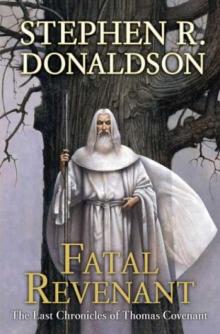 Last Chronicles of Thomas Covenant 02 - Fatal Revenant
Last Chronicles of Thomas Covenant 02 - Fatal Revenant Lord Foul's Bane
Lord Foul's Bane The Gap Into Ruin: This Day All Gods Die
The Gap Into Ruin: This Day All Gods Die White Gold Wielder
White Gold Wielder Fatal Revenant
Fatal Revenant The Mirror of Her Dreams
The Mirror of Her Dreams Against All Things Ending
Against All Things Ending The Real Story: The Gap Into Conflict
The Real Story: The Gap Into Conflict The Power That Preserves
The Power That Preserves Seventh Decimate
Seventh Decimate The Gap Into Power: A Dark and Hungry God Arises
The Gap Into Power: A Dark and Hungry God Arises A Man Rides Through
A Man Rides Through The Gap Into Vision: Forbidden Knowledge
The Gap Into Vision: Forbidden Knowledge The King's Justice: Two Novellas
The King's Justice: Two Novellas The Wounded Land
The Wounded Land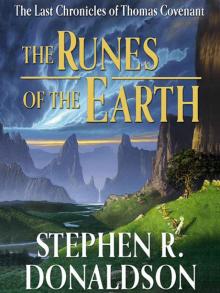 The Runes of the Earth
The Runes of the Earth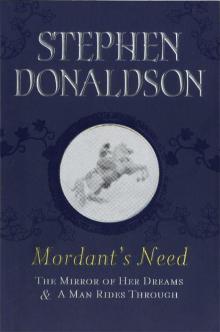 Mordant's Need
Mordant's Need The One Tree
The One Tree Gilden-Fire
Gilden-Fire Reave the Just and Other Tales
Reave the Just and Other Tales The Man Who Fought Alone
The Man Who Fought Alone The Last Dark
The Last Dark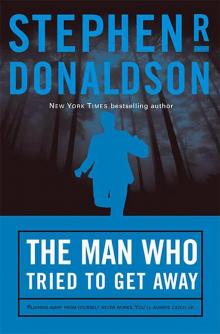 The Man Who Tried to Get Away
The Man Who Tried to Get Away Thomas Covenant 02: The Illearth War
Thomas Covenant 02: The Illearth War A Dark and Hungry God Arises
A Dark and Hungry God Arises The One Tree t2cotc-2
The One Tree t2cotc-2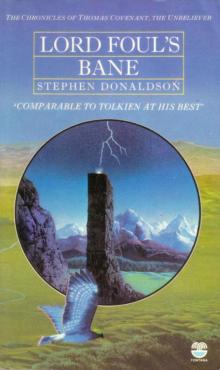 Lord Foul's Bane cotc-1
Lord Foul's Bane cotc-1 The Illearth War t1cotc-2
The Illearth War t1cotc-2 The Runes of the Earth: The Last Chronicles of Thomas Covenant - Book One
The Runes of the Earth: The Last Chronicles of Thomas Covenant - Book One The King's Justice
The King's Justice White Gold Wielder t2cotc-3
White Gold Wielder t2cotc-3 The Power That Preserves t1cotc-3
The Power That Preserves t1cotc-3 Thomas Covenant 01: Lord Foul's Bane
Thomas Covenant 01: Lord Foul's Bane Chaos and Order: The Gap Into Madness
Chaos and Order: The Gap Into Madness Daughter of Regals
Daughter of Regals Forbidden Knowledge: The Gap Into Vision
Forbidden Knowledge: The Gap Into Vision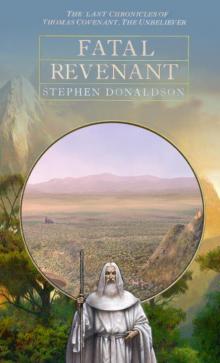 Fatal Revenant t3cotc-2
Fatal Revenant t3cotc-2 The Runes of the Earth t3cotc-1
The Runes of the Earth t3cotc-1 Thomas Covenant 03: Power That Preserves
Thomas Covenant 03: Power That Preserves This Day all Gods Die: The Gap into Ruin
This Day all Gods Die: The Gap into Ruin The Wounded Land t2cotc-1
The Wounded Land t2cotc-1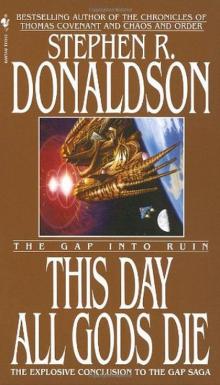 This Day All Gods Die
This Day All Gods Die One Tree
One Tree